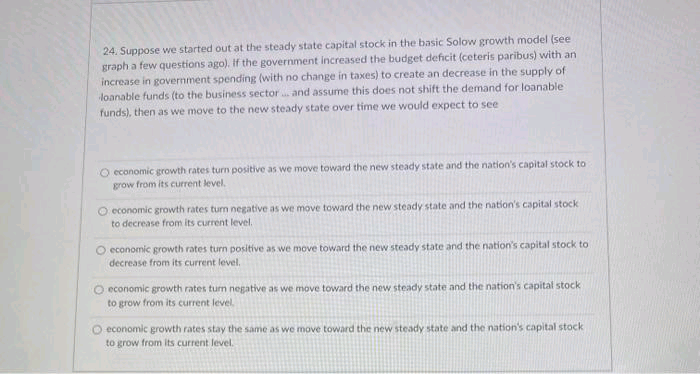24. Suppose we started out at the steady state capital stock in the basic Solow growth model (see graph a few questions ago). If the government increased the budget deficit (ceteris paribus) with an increase in government spending (with no change in taxes) to create an decrease in the supply of loanable funds (to the business sector and assume this does not shift the demand for loanable funds), then as we move to the new steady state over time we would expect to see O economic growth rates turn positive as we move toward the new steady state and the nation's capital stock to grow from its current level. O economic growth rates turn negative as we move toward the new steady state and the nation's capital stock to decrease from its current level. O economic growth rates turn positive as we move toward the new steady state and the nation's capital stock to decrease from its current level. O economic growth rates turn negative as we move toward the new steady state and the nation's capital stock to grow from its current level O economic growth rates stay the same as we move toward the new steady state and the nation's capital stock to grow from its current level.
24. Suppose we started out at the steady state capital stock in the basic Solow growth model (see graph a few questions ago). If the government increased the budget deficit (ceteris paribus) with an increase in government spending (with no change in taxes) to create an decrease in the supply of loanable funds (to the business sector and assume this does not shift the demand for loanable funds), then as we move to the new steady state over time we would expect to see O economic growth rates turn positive as we move toward the new steady state and the nation's capital stock to grow from its current level. O economic growth rates turn negative as we move toward the new steady state and the nation's capital stock to decrease from its current level. O economic growth rates turn positive as we move toward the new steady state and the nation's capital stock to decrease from its current level. O economic growth rates turn negative as we move toward the new steady state and the nation's capital stock to grow from its current level O economic growth rates stay the same as we move toward the new steady state and the nation's capital stock to grow from its current level.
Chapter3: Scarcity, Trade-offs, And Production Possibilities
Section: Chapter Questions
Problem 11P
Related questions
Question

Transcribed Image Text:24. Suppose we started out at the steady state capital stock in the basic Solow growth model (see
graph a few questions ago). If the government increased the budget deficit (ceteris paribus) with an
increase in government spending (with no change in taxes) to create an decrease in the supply of
loanable funds (to the business sector and assume this does not shift the demand for loanable
funds), then as we move to the new steady state over time we would expect to see
O economic growth rates turn positive as we move toward the new steady state and the nation's capital stock to
grow from its current level.
O economic growth rates turn negative as we move toward the new steady state and the nation's capital stock
to decrease from its current level.
O economic growth rates turn positive as we move toward the new steady state and the nation's capital stock to
decrease from its current level.
O economic growth rates turn negative as we move toward the new steady state and the nation's capital stock
to grow from its current level.
O economic growth rates stay the same as we move toward the new steady state and the nation's capital stock
to grow from its current level.
Expert Solution
This question has been solved!
Explore an expertly crafted, step-by-step solution for a thorough understanding of key concepts.
This is a popular solution!
Trending now
This is a popular solution!
Step by step
Solved in 2 steps

Knowledge Booster
Learn more about
Need a deep-dive on the concept behind this application? Look no further. Learn more about this topic, economics and related others by exploring similar questions and additional content below.Recommended textbooks for you

Exploring Economics
Economics
ISBN:
9781544336329
Author:
Robert L. Sexton
Publisher:
SAGE Publications, Inc



Exploring Economics
Economics
ISBN:
9781544336329
Author:
Robert L. Sexton
Publisher:
SAGE Publications, Inc



Economics: Private and Public Choice (MindTap Cou…
Economics
ISBN:
9781305506725
Author:
James D. Gwartney, Richard L. Stroup, Russell S. Sobel, David A. Macpherson
Publisher:
Cengage Learning

Macroeconomics: Private and Public Choice (MindTa…
Economics
ISBN:
9781305506756
Author:
James D. Gwartney, Richard L. Stroup, Russell S. Sobel, David A. Macpherson
Publisher:
Cengage Learning

Economics (MindTap Course List)
Economics
ISBN:
9781337617383
Author:
Roger A. Arnold
Publisher:
Cengage Learning